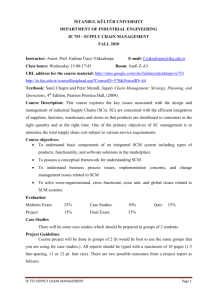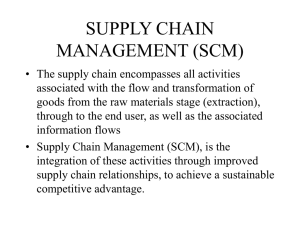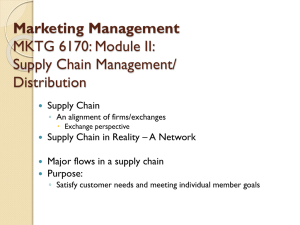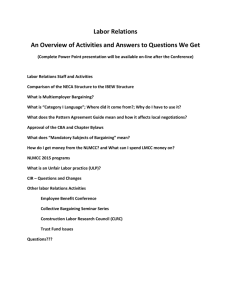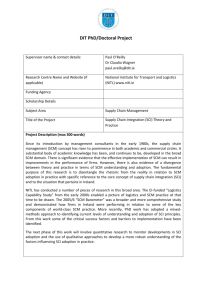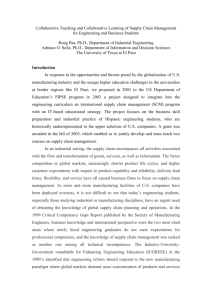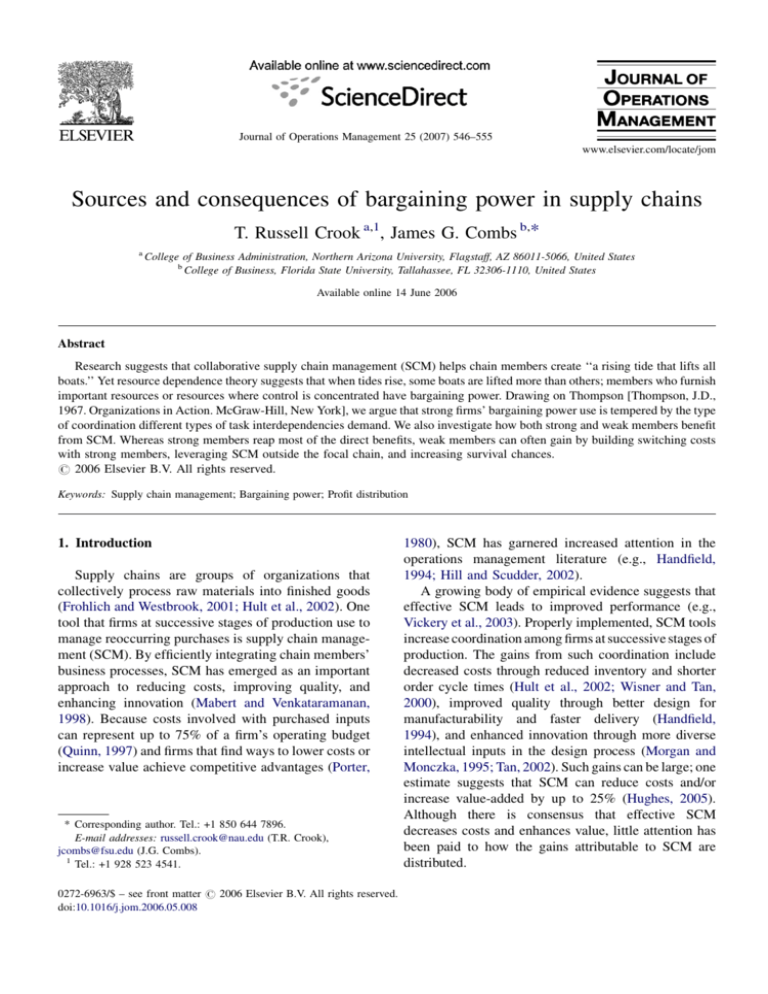
Journal of Operations Management 25 (2007) 546–555
www.elsevier.com/locate/jom
Sources and consequences of bargaining power in supply chains
T. Russell Crook a,1, James G. Combs b,*
a
College of Business Administration, Northern Arizona University, Flagstaff, AZ 86011-5066, United States
b
College of Business, Florida State University, Tallahassee, FL 32306-1110, United States
Available online 14 June 2006
Abstract
Research suggests that collaborative supply chain management (SCM) helps chain members create ‘‘a rising tide that lifts all
boats.’’ Yet resource dependence theory suggests that when tides rise, some boats are lifted more than others; members who furnish
important resources or resources where control is concentrated have bargaining power. Drawing on Thompson [Thompson, J.D.,
1967. Organizations in Action. McGraw-Hill, New York], we argue that strong firms’ bargaining power use is tempered by the type
of coordination different types of task interdependencies demand. We also investigate how both strong and weak members benefit
from SCM. Whereas strong members reap most of the direct benefits, weak members can often gain by building switching costs
with strong members, leveraging SCM outside the focal chain, and increasing survival chances.
# 2006 Elsevier B.V. All rights reserved.
Keywords: Supply chain management; Bargaining power; Profit distribution
1. Introduction
Supply chains are groups of organizations that
collectively process raw materials into finished goods
(Frohlich and Westbrook, 2001; Hult et al., 2002). One
tool that firms at successive stages of production use to
manage reoccurring purchases is supply chain management (SCM). By efficiently integrating chain members’
business processes, SCM has emerged as an important
approach to reducing costs, improving quality, and
enhancing innovation (Mabert and Venkataramanan,
1998). Because costs involved with purchased inputs
can represent up to 75% of a firm’s operating budget
(Quinn, 1997) and firms that find ways to lower costs or
increase value achieve competitive advantages (Porter,
* Corresponding author. Tel.: +1 850 644 7896.
E-mail addresses: russell.crook@nau.edu (T.R. Crook),
jcombs@fsu.edu (J.G. Combs).
1
Tel.: +1 928 523 4541.
0272-6963/$ – see front matter # 2006 Elsevier B.V. All rights reserved.
doi:10.1016/j.jom.2006.05.008
1980), SCM has garnered increased attention in the
operations management literature (e.g., Handfield,
1994; Hill and Scudder, 2002).
A growing body of empirical evidence suggests that
effective SCM leads to improved performance (e.g.,
Vickery et al., 2003). Properly implemented, SCM tools
increase coordination among firms at successive stages of
production. The gains from such coordination include
decreased costs through reduced inventory and shorter
order cycle times (Hult et al., 2002; Wisner and Tan,
2000), improved quality through better design for
manufacturability and faster delivery (Handfield,
1994), and enhanced innovation through more diverse
intellectual inputs in the design process (Morgan and
Monczka, 1995; Tan, 2002). Such gains can be large; one
estimate suggests that SCM can reduce costs and/or
increase value-added by up to 25% (Hughes, 2005).
Although there is consensus that effective SCM
decreases costs and enhances value, little attention has
been paid to how the gains attributable to SCM are
distributed.
T.R. Crook, J.G. Combs / Journal of Operations Management 25 (2007) 546–555
Some have argued that successful SCM improves
financial performance for all chain members (e.g., Tan,
2002; Wisner and Tan, 2000). This implies that chain
members share the spoils of SCM equitably. Others
raise doubts about this possibility. Ketchen and
Giunipero (2004: 53), for example, suggest that while
the SCM literature often seems to assume that ‘‘a rising
tide lifts all boats. . . a chain member may exploit its
partners for its own gain.’’ Thus, effective SCM
potentially creates a rising tide that lifts some, but
not all, boats.
We draw on resource dependence theory (Pfeffer and
Salancik, 1978) to describe the resource qualities that
give some firms bargaining power. We then contribute
to the literature by (1) predicting when stronger firms
use their power and (2) describing the performance
implications of bargaining power use for both strong
and weak members. Specifically, based on Thompson’s
(1967) description of pooled, sequential, and reciprocal
task interdependence, we argue that stronger firms
forbear use of bargaining power when exercising it
might create conflict that would threaten the chain’s
ability to coordinate. A key implication is that the
benefits of SCM vary according to how bargaining
power is used. Thus, we also describe the performance
implications of bargaining power use for both strong
and weak chain members, paying particular attention to
the benefits of SCM, when they exist, for weaker firms.
For researchers, our theorizing should help clarify the
role of bargaining power and its influence over the
creation and distribution of gains from SCM. For
managers, knowing who has power and when it is likely
to be used should aid in negotiations as well as help
build realistic expectations about the potential benefits
of SCM participation.
receive. A seller’s total value-added is Vf Cf, but its
profit is only equal to Pf Cf, which is a function of the
seller’s ability to create value and control costs (Hoopes
et al., 2003).
As shown in Fig. 1, the VPC framework can be
adapted to an entire supply chain, where Vc and Pc
represent the perceived value and price paid by the enduser, and Cc equals the sum of the costs incurred by all
chain members. Part of the difference between Vc and
Cc can be thought of as the sum of all value-added from
the
P individual supply chain members prior to SCM (i.e.,
ðV f C f Þ. However, once the members begin to
practice SCM, the gap between Vc and Cc should widen
further. Assuming increases in Vc Cc translate into
increased Pc Cc, there are gains from SCM that we
label SCM gains.
If a rising tide does indeed lift all boats, we would
expect all supply chain members to appropriate their
pre-SCM profits (i.e., Pf Cf) plus
P a proportional share
of SCM gains (i.e. (Pc Cc) (Pf Cf)). However,
if bargaining power factors into the distribution of SCM
gains (Gomes-Casseres, 1997), stronger firms might
take a disproportionate share of SCM gains, all SCM
gains, or even take all SCM gains plus some of the
weaker firms’ pre-SCM profits.
If bargaining power matters, three questions follow.
First, who within supply chains has bargaining power?
Second, when and how much will stronger members use
their bargaining power? Third, are there benefits from
SCM for weaker members when stronger firms take all
SCM gains and even squeeze their pre-SCM profits? We
draw on resource dependence theory as well as research
2. Sources of profits in supply chains
Understanding how gains from SCM are distributed
requires some knowledge of how supply chain profits
are generated. Supply chain profits can be thought of as
having two major components: (1) the sum of individual
members’ profits, plus (2) some added profits generated
by effective SCM. We refer to the former as pre-SCM
profits and the latter as SCM gains.
The VPC framework provides a useful tool for
decomposing profit sources (Hoopes et al., 2003). For a
single firm, Vf is the value of a good or service to the
buyer, Pf is the buyer’s actual price, and Cf is the firm’s
total costs. The difference between value and price,
Vf Pf, is the consumer surplus, indicating that buyers
typically purchase at prices below the value they
547
Fig. 1. Value creation through use of collaborative SCM.
548
T.R. Crook, J.G. Combs / Journal of Operations Management 25 (2007) 546–555
on bargaining power and task interdependence to shed
light on these questions.
3. Resource dependence and bargaining power
in supply chains
Resource dependence theory views firms as
embedded in a web of exchange relationships within
an uncertain environment and dependent on other
entities for survival (Pfeffer and Salancik, 1978). A
firm’s power within the web resides in others’
dependence on it for resources (Emerson, 1962). Since
long-term cooperative agreements can buffer firms from
hostile environments (Baker, 1990), entry into a supply
chain might be viewed as an attempt to reduce
uncertainty, attain input/output stability, and improve
the probability of survival (Campbell, 1998). These are
the most important organizational goals according to
resource dependence (Pfeffer and Salancik, 1978).
Accordingly, once a firm embraces SCM, other chain
members become key elements of the firm’s environment. This increases the firm’s dependence on the chain
wherein the relative need to acquire resources shapes
each member’s power.
Firms have power to the degree that others depend on
them for resources. Resources create dependencies (1)
when they are important, (2) when control over them is
relatively concentrated, or (3) both (Pfeffer and
Salancik, 1978). Two related factors affect resource
importance–magnitude and criticality. Magnitude is the
proportion of inputs or outputs that a resource
represents for others. A resource is important via
magnitude when firms lack other sustaining activities
should access to the resource be severed.2
Criticality is defined by a firm’s ability to function
without the resource (Pfeffer and Salancik, 1978).
Although high magnitude resources are often critical, it
is possible for a resource to be critical without
representing a large magnitude of purchases or sales.
This occurs, for example, in restaurant franchise chains
where food and labor are the highest magnitude inputs,
but the franchisor’s brand name and operating systems
are also critical (Combs and Ketchen, 1999). Thus, the
franchisor’s control of these critical ingredients gives
them power over franchisees (Hoy, 1994). Because
supply chain value (Vc) would be substantially less
without critical resources, chain members possessing
2
Predictions from resource dependence theory are similar to those
found in Porter’s (1980) five-forces model, though Porter’s model is at
the industry level and requires additional translation to apply to supply
chains.
such resources create dependencies within the chain and
thus amass bargaining power.
The final criterion that gives rise to resource
dependence is the level of concentration of resource
control (Pfeffer and Salancik, 1978). In supply chains,
this means having control over resources where few
competitors control similar resources. A key indicator
of resource control is the level of industry concentration
(Porter, 1980). Concentrated industries are those where
a few competitors generate most sales. Firms in such
industries have bargaining power due to their large
volumes and the small number of alternatives (Benton
and Maloni, 2005). Thus, supply chains that include
members from highly concentrated industries, such as
aircraft assembly and oil refining, cannot easily replace
them, which creates a dependency.
Pfeffer and Salancik (1978) argue that while resource
importance and concentrated control give rise to
dependencies, the interaction between these creates the
strongest dependencies and the most bargaining power.
For example, many of Wal-Mart’s suppliers sell virtually
all of their output to the giant retailer (magnitude).
Because general merchandise retailing has become
concentrated in the hands of a few ‘‘big box’’ retailers,
if Wal-Mart failed to renew a supply agreement, suppliers
have few, if any, outlets to replace lost sales.
Overall, supply chain members offering high
magnitude or critical resources who participate in
highly concentrated industries are stronger. Weaker
members, on the other hand, lack such resources.
Whereas it is an important first step to understand how
resources shape dependencies and hence bargaining
power, it raises the question of when and to what degree
stronger members use their power (e.g., Ketchen and
Giunipero, 2004).
4. Use of bargaining power in supply chains
Firms seek to improve terms and conditions of
exchange through bargaining (Hicks, 1932). Bargaining
power enables stronger firms to gain favorable
exchange terms from others, or more broadly, to coerce
others to do what they would otherwise not do
(Emerson, 1962; Pfeffer, 1981). Although some
research suggests that competition has changed from
one firm competing with another to one supply chain
competing with another (Vickery et al., 1999), chain
members often know the value of the resources they
offer and the dependencies they create. Stronger
members might calculate others’ dependencies and
exert their power during negotiations to appropriate a
larger percentage, if not all, SCM gains. At the extreme,
T.R. Crook, J.G. Combs / Journal of Operations Management 25 (2007) 546–555
stronger members might even negotiate all SCM gains
plus some of weaker members’ pre-SCM profits. Yet in
other situations, stronger members might forbear the
use of power to instead share SCM gains.
We assert that stronger members’ decisions to exercise
versus forbear bargaining power are influenced by the
type of coordination needed to create SCM gains, which
is, in turn, shaped by task interdependence. Coordination
has long been considered a key determinant of task
accomplishment in organization theory (Barnard, 1938);
it aligns actions of those performing different parts of a
task (Gulati et al., 2005). The type of coordination
required depends on the type of task interdependence
faced by actors performing the task (Thompson, 1967).
Thompson (1967) described three types of task
interdependence – pooled, sequential, and reciprocal –
and linked these theoretically with three types of
coordination–standardization, planning and scheduling,
and mutual adjustment. Pooled interdependent tasks are
those where ‘‘each part renders a discrete contribution
to the whole and is supported by the whole’’ and
coordination is accomplished by standardization
(Thompson, 1967: 54). This might occur in a retail
supply chain where separate suppliers do not need to
coordinate with each other and SCM tools that facilitate
standardization, such as using electronic data interchange to share forecast and purchasing information,
sufficiently coordinate suppliers’ inputs. Sequentially
interdependent tasks occur in, for example, manufacturing supply chains where one member’s task must be
completed so another’s can begin; coordination requires
plans and schedules (Thompson, 1967). Finally, in
reciprocally interdependent tasks, actors’ tasks are
related to, and dependent on, each other (e.g., joint
project development—Gulati and Singh, 1998).
Accordingly, such tasks require SCM tools that
facilitate mutual adjustment, such as dedicated on-site
personnel and integrated project development teams.
We contend that as task interdependence moves from
pooled to sequential to reciprocal, and coordination
demands increase correspondingly, stronger firms are
549
more likely to forbear in their use of bargaining power.
Exercising bargaining power generates resentment by
those subject to it and reduces weaker actors’ willingness to cooperate (Gaski, 1984). Indeed, the use of
power increases conflict (Lusch, 1976), reduces
satisfaction (Hunt and Nevin, 1974), and ultimately,
decreases some firms’ willingness to participate
(Frazier and Summers, 1986). When SCM tools that
coordinate via standardization, and to a lesser extent,
plans and schedules, are sufficient, short of outright
sabotage, conflict should not undermine the effectiveness of SCM. However, SCM tools that coordinate via
mutual adjustment typically require active cooperation
and intense communication. Our conjecture is that the
effectiveness of such tools is easily undermined by
conflict and resentment (Kumar and van Dissel, 1996).
Assuming that the effective use of such tools translates
to increased SCM gains, the decision to use bargaining
power becomes critical for both the generation of SCM
gains as well as their distribution.
The proposed linkage among task interdependence,
coordination demands, and use of bargaining power is
depicted in Fig. 2. The link between each type of task
interdependence and bargaining power use is described
below.
4.1. Bargaining power use under pooled
interdependence
Pooled interdependent tasks are those where
members render discrete contributions (Gulati et al.,
2005). Anecdotal evidence suggests that strong firms
use heavy-handed tactics in negotiations for such tasks.
For example, by joining Wal-Mart’s supply chain,
pickle maker Vlasic experienced tremendous sales
growth and reduced costs. However, they charged WalMart such low prices on one particular product, the
gallon jar, that they eventually declared bankruptcy
(Fishman, 2003). In this case, Wal-Mart appropriated all
SCM gains plus much of Vlasic’s pre-SCM profits; the
promotion cannibalized sales in other retail outlets.
Fig. 2. Task interdependence, coordination demands, and bargaining power use.
550
T.R. Crook, J.G. Combs / Journal of Operations Management 25 (2007) 546–555
Pooled interdependent tasks rely on standardized
coordination. Once agreements are signed, forecasts,
payments, and delivery procedures can be standardized
to achieve sufficient coordination. Thus, stronger
supply chain members can exercise bargaining power
maximally because even if conflict results, coordination
should not suffer. This suggests that where task
interdependence is pooled, stronger members will fully
exert bargaining power. Maximally applied bargaining
power implies stronger firms appropriate all SCM gains
plus some portion of weaker members’ pre-SCM
profits. Stated formally, we propose that:
Proposition 1. When task interdependence among supply chain members is pooled, strong members use their
bargaining power to appropriate all SCM gains plus a
portion of weak members’ pre-SCM profits.
4.2. Bargaining power use under sequential
interdependence
Not all strong supply chain members exercise
maximal bargaining power. Dell Computer, for example, controls almost 20% of the computer market
(Kothandaraman and Wilson, 2001) and is, like WalMart, known for using heavy-handed negotiating
tactics. When asked how suppliers benefit from working
with Dell, Michael Dell responded that key supplier
benefits are increased demand visibility and stability
(Magretta, 1998). Implicit in Dell’s response is that
suppliers do not gain directly from SCM. However, Dell
seems to stop short of appropriating suppliers’ pre-SCM
profits. In sequentially interdependent tasks, where one
firm’s outputs become another’s inputs, there is an
increased need for coordination. Downstream members
must coordinate some design elements so different
inputs function together and product performance issues
requiring action must be regularly communicated.
We argue that as long as stronger firms do not
exercise bargaining power to the point where participation in SCM lowers weaker members’ pre-SCM profits,
the level of conflict generated will not interfere with the
plans and schedules needed to coordinate sequentially
interdependent tasks. By capturing all SCM gains,
strong firms might engender some resentment and
conflict among weaker firms. However, as long as preSCM profits are not jeopardized, weaker firms still have
a positive incentive to cooperate because they benefit
from increased volume and greater input/output
stability (Handfield, 1994). Thus, even though the
plans and schedules needed to coordinate sequentially
interdependent tasks might need frequent adjustment
and non-routine information exchange, weaker members should be willing to offer this level of cooperation
because doing so improves their overall performance.
Accordingly, we anticipate that:
Proposition 2. When task interdependence among supply chain members is sequential, strong members use
their bargaining power to appropriate all SCM gains,
but not weak members’ pre-SCM profits.
4.3. Bargaining power use under reciprocal
interdependence
Reciprocally interdependent tasks are those where
each chain member sends outputs to and receives inputs
from others. This type of interdependence occurs in joint
project design (Gulati and Singh, 1998) or the
manufacture of complex products with intricately related
components like aircraft engines and fuselages (Scott,
1998). Because each part of a task is simultaneously
dependent on how others are performed, coordination
must be accomplished by mutual adjustment wherein
members constantly react to each other. When mutual
adjustment is needed, SCM tools such as dedicated onsite personnel, frequent face-to-face meetings, and interfirm project teams are required (Gulati and Singh, 1998).
Some supply chains even develop a shared culture (Hult
et al., 2002). These SCM tools demand a spirit of active
cooperation and open communication, which could
easily be destroyed by conflict or resentment among
members (Wilkinson, 1981). Thus, for reciprocally
interdependent tasks, conflict that undermines effective
mutual adjustment would likely eliminate most of the
available SCM gains. We therefore expect stronger firms
to forbear the use of bargaining power to avoid conflict
and increase SCM gains.
Dyer (1996) describes how Toyota and its supply
chain partners generated SCM gains. He also found that
Toyota consistently outperformed its competitors (e.g.,
Ford or GM), suggesting that Toyota appropriates much
of the gains. However, Toyota’s suppliers also outperformed their competitors (Dyer, 1996), suggesting
that Toyota offers suppliers a positive incentive to
actively increase SCM gains through continued investment. We suggest that Toyota’s use of bargaining power
is due to reciprocal task interdependence. Toyota and its
suppliers coordinate efforts to integrate thousands of
complex parts (Kamath and Liker, 1994). To do so, key
suppliers dedicate personnel, computer aided design
systems, and prototyping facilities to the supply chain
relationship (Kamath and Liker, 1994). Generalizing
from this example, we assert that the mutual adjustment
T.R. Crook, J.G. Combs / Journal of Operations Management 25 (2007) 546–555
demanded by reciprocally interdependent tasks requires
minimum conflict. Thus, for such tasks, stronger supply
chain members will forbear their use of bargaining
power and share at least some SCM gains with weaker
members. Stated formally:
Proposition 3. When task interdependence among supply chain members is reciprocal, strong members will
forbear their use of bargaining power and share SCM
gains with weak members.
5. Benefits of supply chain membership
We have argued that bargaining power and the
influence of task interdependence on coordination
demands determines the distribution of SCM gains.
This raises questions regarding how stronger and
weaker members gain from SCM under different task
interdependencies.
5.1. Key SCM benefits for stronger members
The most obvious beneficiaries of SCM are stronger
members who, at a minimum, appropriate a large share
of SCM gains. These are the benefits typically described
by SCM advocates: (1) profit gains from lower costs, (2)
increased value, and (3) enhanced innovative capacity
(Elmuti, 2002; Tan, 2002). They also benefit from
increased bargaining power outside the focal chain.
Lower costs are achieved through improved scale
economies (Handfield and Nichols, 2002), reduced
inventory (Tan, 2002), shorter cycle times (Handfield
and Nichols, 2002) and lower coordination costs (Hill
and Scudder, 2002). SCM increases value through more
innovative new product development (Hult et al., 2000),
improved component quality, and reduced new product
development times (Primo and Amundson, 2002).
Enhanced innovative capacity occurs when stronger
firms learn and assimilate innovative practices from
their smaller, often more entrepreneurial, partners (e.g.,
Hamel, 1991; Powell et al., 1996). A fourth SCM
benefit for stronger members is that as volumes increase
and bargaining power grows, suppliers or buyers outside
the focal chain might make additional concessions (e.g.,
Porter, 1980).
Although there are many SCM benefits available to
strong members, implicit in our argument is that these
benefits are greatest when strong members match their
use of bargaining power to the type of task interdependence. Indeed, failure to forbear when task
interdependence is reciprocal might lead to unnecessary
conflict and a reduction in cooperation when it is most
551
needed. Dyer’s (1996) study offers a compelling
example. His study showed that U.S. automobile
manufacturers and their suppliers had higher procurement costs than their Japanese counterparts. Dyer
argued that at least part of the difference was due to the
use of bargaining power. Japanese firms adopted a
cooperative approach and shared SCM gains; U.S.
automobile manufacturers pitted prospective supply
chain members against each other by auctioning supply
contracts to the lowest bidder (Konrad, 2000; Smeltzer
and Carr, 2002). Not surprisingly, GM’s approach
created contentious, not cooperative relationships
(Beall et al., 2003) that appear to have reduced
potential SCM gains. This suggests that failure to
match bargaining power use to the type of task
interdependence can have serious consequences; coordination is reduced, procurement costs increase, and
SCM gains shrink. Fewer available SCM gains should
translate into lower profits. Accordingly, we expect that:
Proposition 4. Failure to match bargaining power use
to the type of task interdependence reduces profitability
for strong supply chain members.3
5.2. Key SCM benefits for weaker members
Regardless of the type of interdependence, when
strong firms forbear, weak members gain because they
keep their pre-SCM profits plus accrue SCM gains. It is
probably rare for strong members to forbear under
pooled interdependence; sharing SCM gains would
engender more cooperation than what is needed. Under
reciprocal interdependence,4 we proposed that strong
firms forbear bargaining power so that effective
coordination through mutual adjustment can be
achieved and SCM gains maximized. Thus, regardless
of why forbearance occurs, when it happens, the
benefits of SCM for weaker firms mirror those of their
stronger counterparts.
5.2.1. When strong members do not forbear under
low task interdependence
If, as we assert, strong members under pooled task
interdependence exercise their bargaining power to
3
It is possible for a strong member to forbear bargaining power use
under pooled interdependence and thus share SCM gains when it is
not necessary. The proposition would still hold.
4
For parsimony, we focus our discussion of weaker members’
outcomes on the extreme positions of pooled and reciprocal task
interdependence. Outcomes under sequential interdependence should
fall somewhere between.
552
T.R. Crook, J.G. Combs / Journal of Operations Management 25 (2007) 546–555
appropriate all SCM gains plus some portion of weak
members’ pre-SCM profits, an important question is:
how do weak members benefit from chain membership?
There are at least three potential benefits: (1)
opportunities to increase future bargaining power by
building switching costs, (2) leveraging supply chain
membership outside the focal chain, and (3) increasing
the probability of survival.
Bargaining power is dynamic and changes over time
(Das and Teng, 2000; Inkpen and Beamish, 1997). One
way weaker members can improve their bargaining
position is by creating switching costs (e.g., Porter, 1980).
Switching costs are created when a firm’s customers
become accustomed to its products or how they are
delivered (Stratman et al., 2004). Once a buyer’s
employees adopt new software, for example, they often
become reluctant to change because of product familiarity, efficiency of use, and retraining costs. For example,
although office products are neither a large magnitude of
purchases nor critical to most downstream buyers, Office
Max builds some power for itself by training its customers
on proprietary information systems that simplify transactions (Office Max and Incorporated, 2006).
Weaker chain members might also benefit by
leveraging SCM outside the focal chain. Firms
practicing SCM learn new skills and competencies
(Hamel, 1991) that weaker members can then leverage
to improve performance outside the chain (e.g., Mowery
et al., 1996). A weak member, for example, may learn
new manufacturing techniques that lower costs on
products sold outside the focal chain where customers
are less likely to bargain away the savings. Further,
weaker members often grow in size through supply
chain membership (Frohlich and Westbrook, 2001),
which increases economies of scale. Although stronger
members within the chain should appropriate cost
savings derived from improved scale economies, this
might not be the case with firms outside the focal chain.
As weak members grow, so too does their bargaining
power (Porter, 1980), which should enable them to gain
volume discounts outside the focal chain.
Increased probability of survival is a third advantage
of chain membership for weak members. Whereas
entering a supply chain increases weaker firms’
dependency on the chain, it reduces uncertainty in
what might be a hostile environment outside the chain
(Baker, 1990). Thus, from the perspective of resource
dependence theory, entering a supply chain reduces
uncertainty, increases stability of resource access
(Campbell, 1998), and thereby increases the probability
of survival, which is the most important organizational
goal (Pfeffer and Salancik, 1978). Affiliation with
stronger chain members might also improve survival
chances by increasing legitimacy (Wiewel and Hunter,
1985). Stronger members might be prestigious firms
with reputations for innovation or high quality. Weaker
members with ties to such firms increase their
legitimacy (DiMaggio and Powell, 1983; Gulati
et al., 2000), which allows weak members to attract
new customers that were once beyond reach. Thus,
supply chain membership increases survival chances for
weaker members even though they do not appropriate
SCM gains.
In sum, even though strong firms will likely
appropriate SCM gains and also cut into weaker firms’
pre-SCM profits, at least three benefits remain for
weaker firms to continue participation in SCM under
pooled interdependence. Stated formally, these are:
Proposition 5. When task interdependence is pooled
and stronger members appropriate all SCM gains plus
some pre-SCM profits, weaker firms still benefit from
chain membership by: (1) building switching costs that
increase bargaining power over time, (2) leveraging
membership outside the focal chain, and (3) increasing
probability of survival.
5.2.2. When strong members do not forbear under
high task interdependence
As described in Proposition 4, the worst situation is
when strong firms fail to forbear their use of bargaining
power under conditions of reciprocal task interdependence. SCM gains are significantly reduced because
weaker firms are unlikely to furnish the active
cooperation needed to coordinate via mutual adjustment. For stronger firms, although they might capture
all SCM gains plus some portion of weaker members’
pre-SCM profits, the SCM gains that are captured are
much less than the potential gains that might have
materialized if they had secured their weaker partners’
active cooperation. We would still expect some gains
from SCM, such as efficiencies from using electronic
data interchange, because such gains only require
coordination through standardization. However, other
potential SCM gains, such as value enhancing innovations and cost saving design for manufacturability,
require mutual adjustment, which is unlikely to occur
when strong firms fully exercise bargaining power.
Based on population ecology theory, which draws on
the metaphor of natural selection from biology (Hannan
and Freeman, 1977), we believe that failure to create
available SCM gains jeopardizes the entire chain.
Further, weak firms bear disproportional survival risks
(Aldrich and Auster, 1986). Population ecology argues
T.R. Crook, J.G. Combs / Journal of Operations Management 25 (2007) 546–555
that structural inertia caused by internal factors, such as
communications structures and internal politics, and
external factors, such as barriers to entry and perceived
legitimacy, hinders adaptation to environmental change
(Hannan and Freeman, 1977). Importantly, if the
population of organizations is dense, meaning competition is strong, and a competitive innovation is
introduced into the environment, such as SCM, firms
that do not adapt are likely to fail (Haveman, 1992).
Population ecology models are typically applied to
firms. However, if we adopt Vickery et al.’s (1999)
argument that competition is between supply chains, the
implication is that if the environment is competitive (or
dense), chains that are unable to capture the full
potential benefits of SCM will have greater mortality.
From a population ecology perspective, structural
inertia makes it difficult to switch from a competitive
to a cooperative stance, even when task interdependence
dictates that such a stance is necessary. Consequently, as
the density of the competitive environment among
chains increases, the greater the probability of chainwide failure, and those chains most likely to be selected
for failure are those that have been unable to capture
available SCM gains. Thus, we expect that:
Proposition 6. When task interdependence is reciprocal and stronger members appropriate all SCM gains
plus some pre-SCM profits, both strong and weak firms
have higher mortality rates than those in competing
chains.
Another outcome of population ecology research is
that smaller firms have higher mortality (Aldrich and
Auster, 1986). Stronger firms are often larger; they
might be able to survive for some time by pressuring
weaker firms to give up a greater portion of their preSCM profits. Weaker members might respond by
attempting to build switching costs, but switching costs
also increase weaker firms’ ties to the declining chain.
Further, the knowledge and reputational spillovers that
are available to weaker firms in chains where
forbearance is not expected are less beneficial if
knowledge sharing is not on par with competitors and
stronger firms’ reputations are in decline. Consequently,
where overexertion of bargaining power under conditions of reciprocal task interdependence leads to a loss
of potential SCM gains, weak members should confront
very high levels of mortality. Accordingly:
Proposition 7. When task interdependence is reciprocal and stronger members appropriate all SCM gains
plus some pre-SCM profits from weaker firms, mortality
rates are highest among weak firms.
553
6. Implications for future research
Our overarching objective was to predict the use of
bargaining power in supply chains and draw a more
realistic picture of SCM benefits for most members.
Drawing on resource dependence theory to describe
who within supply chains has bargaining power, we
built a testable theory around Thompson’s (1967)
description of task interdependence that predicts when
strong firms will exercise their power. Our theorizing
suggests that the benefits of SCM vary according to
bargaining power use. Thus, we also describe the
benefits, when they exist, of SCM for both stronger and
weaker members.
Beyond empirically testing the propositions, we
believe that future research would benefit by investigating three issues that emerge from our analysis. The first
involves the conceptual difference between value
creation and bargaining power. According to the VPC
framework (Hoopes et al., 2003), the total value created
by a supply chain can be thought of as the sum of the
value-added by each firm, which we call pre-SCM
profits, plus SCM gains. Based on resource dependence
theory, we argued that those firms that furnish important
resources where control is concentrated have the most
bargaining power and thus appropriate a disproportionate share of the chain’s total value created.
However, value creation and bargaining power are
closely linked (Gomes-Casseres, 2005). Not only do
resources that are important or tightly controlled create
bargaining power, they are valuable. Thus, rather than
viewing bargaining power as the source of profit
appropriation, the profits given up by weaker firms
could be viewed as the market price for accessing
stronger firms’ valuable and scarce resources (Cox,
2001). Some effort is needed to clarify the degree to
which a resource’s value and its ability to confer
bargaining power are distinct. Such an effort will
necessarily address the efficiency of markets. Taking
the Vlasic pickle example, the question is whether
Vlasic offered nothing of value or whether Vlasic
created value, but Wal-Mart used its market power to
extract it all. The former assumes the market is
efficiently delivering profits to those whose resources
create value, whereas the latter assumes that a market
inefficiency (i.e., power) keeps firms from claiming
profits they generate.
A second question raised by our analysis pertains to
how the benefits of SCM shift. We have suggested that
weaker firms can build switching costs and concomitant
bargaining power over time. If so, power imbalances
should lessen as supply chain membership length
554
T.R. Crook, J.G. Combs / Journal of Operations Management 25 (2007) 546–555
increases. Changes in bargaining power create instability in cooperative relationships (Inkpen and Beamish,
1997). Thus, an alternative explanation for forbearance
might be that stronger firms attempt to maintain
stability in anticipation of bargaining power shifts.
However, if weaker firms are unable to establish some
power, the implications of a long-term power imbalance
remain unexplored. Only about one-half of inter-firm
cooperative arrangements succeed (Barringer and
Harrison, 2000) and one reason they fail is due to
power imbalances (Lambert et al., 1999). Thus, it is
possible that persistent tension among chain members
might jeopardize even those SCM gains that require
little coordination.
A third issue that warrants attention is the relationship between available gains from SCM and task
interdependence. We have argued that stronger firms
forbear their use of bargaining power to attain the type
of coordination needed for a given type of task
interdependence. In doing so, we have suggested that
the amount of SCM gains that can be created grows with
task interdependence. In pooled interdependent tasks
coordinated by standardization, SCM gains appear
mainly by reducing inventory, order processing, and
distribution costs (Handfield and Nichols, 2002). As
task interdependence moves from pooled to sequential
to reciprocal, however, greater value creation is possible
because there are more opportunities for members to
actively coordinate to improve costs, quality, and the
innovativeness of the supply chain’s final products or
services (Elmuti, 2002; Tan, 2002). Thus, future
research might benefit from further exploring the
relationship between task interdependence and available gains from SCM.
7. Conclusion
As SCM becomes increasingly important to firms
competing in today’s global economy, the need to
understand how supply chains create and distribute
value has increased (Ketchen and Giunipero, 2004).
Much of the current literature is based on the
normative premise that SCM implementation creates
a rising tide that lifts all boats. However, resource
dependence theory suggests that important differences in bargaining power exist among supply chain
members. Building on Thompson’s (1967) description
of pooled, sequential, and reciprocal task interdependence, we propose that stronger chain members use
their bargaining power when task interdependence is
low, but forbear its use when task interdependence is
high. Our hope is that knowledge about the presence
and appropriate use of bargaining power will not
only help weaker firms develop realistic expectations
about the benefits of SCM, but help stronger and
weaker firms alike improve their performance over
the long run.
References
Aldrich, H., Auster, E., 1986. Even dwarfs started small: liabilities of
age and size and their strategic implications. In: Staw, B., Cummings, L. (Eds.), Research on Organizational Behavior. JAI Press,
Greenwich, CT, pp. 165–198.
Baker, W., 1990. Market networks and corporate behavior. American
Journal of Sociology 96, 589–625.
Barnard, C., 1938. The Functions of the Executive. Harvard University
Press, Cambridge, MA.
Barringer, B., Harrison, J., 2000. Walking a tightrope: creating value
through interorganizational relationships. Journal of Management
26 (3), 367–403.
Beall, S., Carter, C., Carter, P., Germer, T., Hendrick, T., Jap, S.,
Kaufmann, L., Maciejewski, D., Monczka, R., 2003. The Role of
Reverse Auctions in Strategic Sourcing. CAPS Research.
Benton, W., Maloni, M., 2005. The influence of power driven buyer/
seller relationships on supply chain satisfaction. Journal of Operations Management 23, 1–22.
Campbell, A., 1998. Cooperation in international value chains:
comparing an exporter’s supplier versus customer relationships.
Journal of Business and Industrial Marketing 13, 22–39.
Combs, J., Ketchen, D., 1999. Explaining interfirm cooperation and
performance: toward a reconciliation of predictions from the
resource-based view and organizational economics. Strategic
Management Journal 20, 867–888.
Cox, A., 2001. Understanding buyer and supplier power: a framework
for procurement and supply competence. Journal of Supply Chain
Management 37, 8–15.
Das, T., Teng, B., 2000. Instabilities of strategic alliances: an internal
tensions perspective. Organization Science 11, 77–101.
DiMaggio, P., Powell, W., 1983. The iron cage revisited: institutionalized isomorphism and collective rationality in organizational
fields. American Sociological Review 48, 147–160.
Dyer, J., 1996. Specialized supplier networks as a source of competitive advantage: evidence from the auto industry. Strategic Management Journal 17, 271–291.
Elmuti, D., 2002. The perceived impact of supply chain management
on organizational effectiveness. Journal of Supply Chain Management 38 (3), 49–57.
Emerson, R., 1962. Power-dependence relations. American Sociological Review 27, 31–41.
Fishman, C., 2003. The Wal-Mart you don’t know. Fast Company 77,
68.
Frazier, G., Summers, J., 1986. Perceptions of interfirm power and its
use within a franchise channel of distribution. Journal of Marketing Research 23 (2), 169–176.
Frohlich, M., Westbrook, R., 2001. Arcs of integration: an international study of supply chain strategies. Journal of Operations
Management 19 (2), 185–200.
Gaski, J., 1984. The theory of power and conflict in channels of
distribution. Journal of Marketing 48 (3), 9–29.
Gomes-Casseres, B., 1997. Alliance strategies of small firms. Small
Business Economics 1, 33–44.
T.R. Crook, J.G. Combs / Journal of Operations Management 25 (2007) 546–555
Gomes-Casseres, B., 2005. How alliances shape competition. In:
Shenkar, O., Reuer, J. (Eds.), Handbook of Strategic Alliances.
Sage, Newbury Park, CA, pp. 39–54.
Gulati, R., Singh, H., 1998. The architecture of cooperation: managing
coordination costs and appropriation concerns in strategic alliances. Administrative Science Quarterly 43, 781–794.
Gulati, R., Lawrence, P., Puranam, P., 2005. Adapting in vertical
relationships: beyond incentive conflict. Strategic Management
Journal 26 (5), 415–440.
Gulati, R., Nohria, N., Zaheer, A., 2000. Strategic networks. Strategic
Management Journal 21, 203–215.
Hamel, G., 1991. Competition for competence and inter-partner
learning within international strategic alliances. Strategic Management Journal 12, 83–103.
Handfield, R., 1994. U.S. global sourcing: patterns of development.
International Journal of Operations and Production Management
14 (6), 40–51.
Handfield, R., Nichols, E., 2002. Supply Chain Redesign. Prentice
Hall, Upper Saddle River, NJ.
Hannan, M., Freeman, J., 1977. The population ecology of organizations. American Journal of Sociology 83, 929–984.
Haveman, H., 1992. Between a rock and a hard place: organizational
change and performance under conditions of fundamental environmental transformation. Administrative Science Quarterly 37
(1), 48–75.
Hicks, J.R., 1932. The Theory of Wages. Macmilan Press, London,
UK.
Hill, C., Scudder, G., 2002. The use of electronic data interchange for
supply chain coordination in the food industry. Journal of Operations Management 20 (4), 373–387.
Hoopes, D., Madsen, T., Walker, G., 2003. Guest editors’ introduction
to the special issue: why is there a resource-based view? Toward a
theory of competitive heterogeneity. Strategic Management Journal 24, 889–902.
Hoy, F., 1994. The dark side of franchising. International Small
Business Journal 12, 26–38.
Hughes, J., 2005. What is Supplier Relationship Management and
Why Does it Matter. White Paper. Vantage Partners (http://
www.vantagepartners.com).
Hult, G.T.M., Hurley, R., Giunipero, L., Nichols, E., 2000. Organizational learning in global purchasing: a model and test of internal
users and corporate buyers. Decision Sciences 31 (2), 293–325.
Hult, G.T.M., Ketchen, D., Nichols, E., 2002. An examination of
cultural competitiveness and order fulfillment cycle time within
supply chains. Academy of Management Journal 45 (3), 577–586.
Hunt, S., Nevin, J., 1974. Power in a channel of distribution: sources
and consequences. Journal of Marketing Research 11, 186–193.
Inkpen, A., Beamish, P., 1997. Knowledge, bargaining power, and the
instability of joint ventures. Academy of Management Review 22,
177–202.
Kamath, R., Liker, J., 1994. A second look at Japanese product
development. Harvard Business Review 72, 154–173.
Ketchen, D., Giunipero, L., 2004. The intersection of strategic management and supply chain management. Industrial Marketing
Management 33 (1), 51–56.
Konrad, R., 2000. Old and New Economies Clash in Auto Industry
Marketplace. CNET News.
Kothandaraman, P., Wilson, D., 2001. The future of competition:
value creating networks. Industrial Marketing Management 30,
379–389.
555
Kumar, K., van Dissel, H., 1996. Sustainable coollaboration: managing conflict and cooperation in interorganizational systems. MIS
Quarterly 20 (3), 279–300.
Lambert, D., Emmelhainz, M., Gardner, J., 1999. Building successful
logistics partnerships. Journal of Business Logistics 20 (1), 165–
181.
Lusch, R., 1976. Source of power: their impact on intrachannel
conflict. Journal of Marketing Research 13 (4), 382–390.
Mabert, V., Venkataramanan, M., 1998. Special research focus on
supply chain linkages: challenges for design and management in
the 21st century. Decision Sciences 29, 537–552.
Magretta, J., 1998. The power of virtual integration. An interview with
Michael Dell. Harvard Business Review 76, 73–84.
Morgan, J., Monczka, R., 1995. Alliances for new products. Purchasing 18 (1), 103–109.
Mowery, D., Oxley, J., Silverman, B., 1996. Strategic alliances and
interfirm knowledge transfer. Strategic Management Journal 17,
77–91.
Office Max Incorporated, 2006. http://www.officemax.com. Accessed
April, 2006.
Pfeffer, J., 1981. Power in Organizations. Pitman, Marshfield, MA.
Pfeffer, J., Salancik, G., 1978. The External Control of Organizations:
A Resource Dependence Perspective. Harper and Row, New York.
Porter, M.E., 1980. Competitive Strategy. Free Press, New York.
Powell, W., Koput, K., Smith-Doerr, L., 1996. Interorganizational
coollaboration and the locus of innovation: networks of learning in
biotechnology. Administrative Science Quarterly 41, 116–145.
Primo, M., Amundson, S., 2002. An exploratory study of the effects of
supplier relationships on new product development outcomes.
Journal of Operations Management 20 (1), 33–52.
Quinn, F.J., 1997. What’s the buzz? Logistics Management 36 (2),
43–46.
Scott, W.R., 1998. Organizations: Rational, Natural, and Open Systems. Prentice Hall, Upper Saddle River, NJ.
Smeltzer, L., Carr, A., 2002. Electronic reverse auctions: promises,
risks, and conditions for success. Industrial Marketing Management 45, 47–52.
Stratman, J., Roth, A., Gilland, W., 2004. The deployment of temporary production workers in assembly operations: a case study of
the hidden costs of learning and forgetting. Journal of Operations
Management 21 (6), 689–707.
Tan, K., 2002. Supply chain management: practices, concerns, and
performance issues. Journal of Supply Chain Management 38 (1),
42–53.
Thompson, J.D., 1967. Organizations in Action. McGraw-Hill, New
York.
Vickery, S., Calantone, R., Droge, C., 1999. Supply chain flexibility: an
empirical study. Journal of Supply Chain Management 35, 16–24.
Vickery, S., Jayaram, J., Droge, C., Calantone, R., 2003. The effects of
integrative supply chain strategy on customer service and financial
performance: an analysis of direct versus indirect relationships.
Journal of Operations Management 21 (5), 523–539.
Wiewel, W., Hunter, A., 1985. The interorganizational network as a
resource: a comparative case study on organizational genesis.
Administrative Science Quarterly 30, 482–496.
Wilkinson, I., 1981. Power, conflict, and satisfaction in distribution
channels—an empirical study. International Journal of Physical
Distribution and Materials Management 11, 20–30.
Wisner, J., Tan, K., 2000. Supply chain management and its impact on
purchasing. Journal of Supply Chain Management 36 (4), 33–42.

